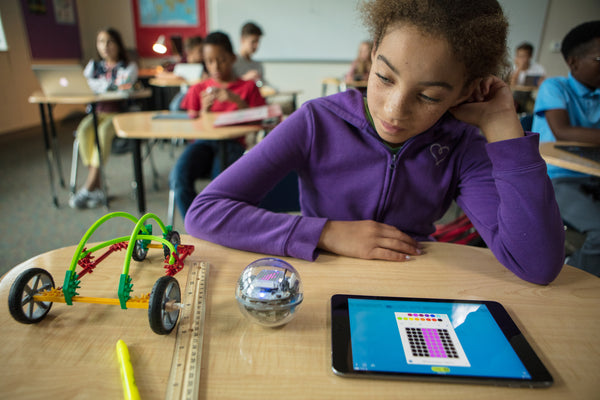In today’s quick-to-change world, it’s more important than ever that we prepare students to solve tomorrow’s problems. If we hope to crack the world’s most challenging issues, we need more innovative thinkers, self-driven inventors, and creative problem-solvers in the workplace. The solution is clear: to meet the talent demand, we need to focus on STEM education in school. To help achieve this goal, the United States Department of Education invested more than $500 million in Fiscal Year 2019 to support STEM education. Still, there’s more that we – as educators – can do.
What is STEM education and why is it important?
STEM education is an interdisciplinary approach to education that provides students with hands-on learning experiences in four specific STEM fields, or disciplines: science, technology, engineering, and mathematics. By learning STEM in school, students can develop the fundamental skills needed to thrive in the workplace. STEM education creates critical thinkers, inventors, and leaders. These types of roles are in high demand, and STEM learning cultivates this talent in droves. How is STEM education different from traditional education?
STEM education moves away from traditional teaching methods, which primarily include memorizations, lectures and demonstrations. This makes sense: there is plenty of research that suggests educators should refresh their usual approach to teaching in order to reach more students in today’s learning environment. While many students fail to respond to traditional methods of teaching, STEM education offers a compelling alternative.
Once a STEM program is introduced to a school district or classroom, teachers and students engage more frequently in interactive and hands-on educational projects. These activities not only help students retain information better, but they also encourage the use of deductive reasoning, creative thinking, and other important STEM skills.
At Sphero, we’ve seen this firsthand. We partner with many educators, supporting them with learning tools and STEM resources that make teaching STEM in the classroom easy and accessible.
Here’s what a Hannah Jimenez, a teacher at Rochelle Middle School in North Carolina teacher Sphero Hero, shared about our program: “Sphero has changed how students engage with abstract ideas in the classroom, where before students were confused and bored with learning, now students get excited about engaging with new ideas and concepts. Sphero creates an environment of collaboration and critical thinking where each student's creativity is allowed to flourish!”
What are the benefits of STEM education?
A huge plus in favor of STEM education is its effect on student engagement. The secret is out: learning STEM can increase students’ engagement at school. When students are interested in what they’re learning, they’re more engaged, they retain information better, and they’re more excited about coming to school every day. This leads to better performance on tests and evaluations.

Many students who receive a quality STEM education:
- Are excellent problem-solvers
- Are effective communicators
- Thrive in high-pressure environments
- Show innovative thinking
- Work well with others
Increasing students’ enjoyment and their performance in school are just two of the positive effects that teaching STEM has on communities. This impact stretches beyond schools – all the way to the community at large.
Check out this data collected by the Science Foundation Arizona. It shows that teaching STEM correlates with lower unemployment rates in the overall community. The organization found that there were 1.7 jobs open for every STEM professional. Meanwhile, there were 4.1 people unemployed for every non-STEM job. Not only do students who had the benefit of a STEM education find work, but they're also very well paid. The average median hourly wage for former STEM education students is about $38.85, whereas people who received a traditional education earn about $19.30 per hour.
It should come as no surprise that STEM education is a pathway for success for many students. Educators can pave the way by incorporating a STEM curriculum into the school district, classroom, and educational community.
How can STEM Education Shape the Future?
As mentioned above, there are several benefits to teaching and learning STEM. Aside from the technical skills and subject areas learned, STEM education ensures kids have the necessary 21st century skills to flourish as adults and be prepared for the jobs of tomorrow.
The U.S. Department of Commerce recently reported that STEM occupations are projected to grow by 8.9 percent from 2014 to 2024, compared to 6.4 percent growth for non-STEM occupations. This puts STEM at the forefront of many kids’ future career paths, which is why it’s important to introduce STEM and STEAM activities at the right time in their education journey.
When to Start STEM education
One of the best things about STEM education is that it can be applied to early childhood learning and into elementary school. Young kids, including toddlers, can learn STEM principles through hands-on, play-based activities. This works out well because kids are naturally curious and like to explore the world around them.
Whether they’re building bridges and towers with blocks, or learning about shadows, bubbles and ice, opportunities to teach young children though STEM education is all around.
How to Teach STEM Education
Folding STEM into your existing educational program doesn't have to be hard, though it does take some pre-planning, patience, and drive. Educators will need to pull up their sleeves, coach their peers, and nudge the community to focus on STEM education.

Fortunately, there are many ways that educators can push the cart toward an engaging STEM curriculum. Doing these things now will help gain support and make the transition from traditional learning to STEM learning as seamless as possible. Buckle up!
4 tips for incorporating STEM learning into your educational program
1. Define your purpose
An important step toward building a STEM school is to clearly define your purpose and answer your “Why?” Now, you don’t need to reinvent the wheel. For example, your purpose may be “to provide students with the highest quality education possible and prepare them to take on tomorrow’s biggest problems.” If it helps, think of your purpose like a school motto. Your purpose is something that others in the school and educational community need to get behind. Stand by it.
By making this purpose known, you’re helping teachers, parents, and students know what to expect during the upcoming school year or semester. Continue to repeat this message often – in school newsletters, community events, and school-wide assemblies. Eventually, you can build onto it and include your values and beliefs as a leading STEM school.
2. Invite parents to participate in STEM focus groups
Focus groups provide educators with an opportunity to listen to the community and address their STEM-related questions. Inviting parents to focus groups that explore STEM education is a great way to not only help you promote STEM learning at your school but also to ensure that parents are actively involved in their child's education. You can ask STEM leaders to be guest speakers or include group activities that encourage participants’ engagement. The National Academies of Science, Engineering, and Medicine, for example, conducted focus groups with faculty members and students and tasked them with exploring solutions to barriers preventing students from pursuing STEM-centric majors in higher education.

Focus groups will help you learn more about the needs of your community and allow the community to learn more about STEM education. More so, inviting parents to the focus group will help you better understand their perspective. You can then use this knowledge to inform your STEM curriculum decision making and enhance your STEM program once it’s up and running.
3. Apply for STEM grants
There are tons of opportunities out there for educators to fund their STEM program using grants. To make things easier, many government agencies provide resources for educators to find funding. Some of these tools include tips and best practices for the application process, too.
Educators will need to pursue these routes if they hope to develop an effective STEM curriculum. Remember: STEM is an investment. Though the returns are high for both institutions and students, many are slow to adopt a STEM curriculum. We expect this to change in big ways over the next few years as more and more emphasis is placed on STEM and STEAM. Educators embracing STEM now will be better equipped to navigate this changing landscape. They’ll receive more funding in the future. Those that wait will waste valuable time catching up.
4. Create an Outstanding STEM Curriculum
Of course, one of the most important components needed to bring STEM to your community, school district, or classroom is to create a terrific STEM curriculum. There are many ways that educators can turn their vision into reality.

In our experience, we’ve seen some of the most successful STEM curriculums start with educators stepping back and examining their strengths, listing their assets, and identifying their needs. Take a long look at your current faculty and staff members, assess their strengths and skills, and take note of any gaps. Use this knowledge to plan your curriculum. Structure it accordingly.
While STEM is cross-discipline, some schools may decide to emphasize a specific subject because of their strengths or resources on hand. For example, one school might decide to make their program science-focused while another might prefer to lean on technology because of the resources they have access to. There is no right or wrong way. That being said, educators still need to ensure their STEM curriculum is balanced across all STEM fields. By understanding your strengths and needs, you can more effectively plan your curriculum and determine what gaps you need to fill.
Another great way to prepare a STEM curriculum is to place faculty members on research teams. The research team can learn from other schools in the community, participate in educational forums, and speak with others about STEAM activities and project-based learning. Having faculty members involved helps get them on board with the program early on and encourages them to discover STEAM activities they can use in their classroom.
These are just some of the ways that educators can bring STEM education to their communities. At Sphero, we’ve partnered with tens of thousands of educators and helped them develop STEM curriculums and programs. We offer resources to train teachers and empower them to go beyond code in the classroom. We specialize in equipping schools just like yours with the right tools to create a truly spectacular STEM education program.
For more information, you can get in touch with our team to learn how Sphero can help you introduce STEM to your school district or classroom.






